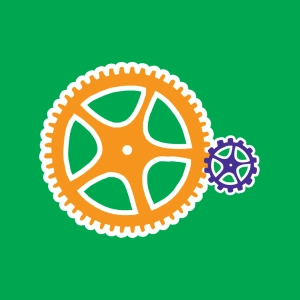 Gears sketch
Gears sketch
Learning objectives
- To make a gear train and identify the drive wheel and the driven wheel(s).
- To illustrate how to convey a movement through a chain.
- To calculate a transmission ratio.
- To explain how the bike works and the ability to change gears.
A gear train is formed when at least two toothed wheels are interconnected. Only a toothed wheel is driving. The others are just trained (or "led"). A smaller driven wheel than the driver wheel will rotate faster and conversely a larger driven wheel will rotate more slowly.
It is on this principle that the mechanisms of changes of speed are based. The gear ratio is also called the "transmission ratio". The gear system + chain transmission of the bike is a very good illustration of the transmission of a rotational movement between two wheels. The rotation speed of the rear gears depends on the transmission ratio between the platform (front wheel) and the pinion (rear wheel).
To find the transmission ratio of a gear train is to compare the numbers of teeth and thus the radii.
Draw a circle in the screen to create a wheel. The size of the wheels is constrained to illustrate simple ratios: 10, 15, 20, 30, 40, 50, 60 teeth.
The driving wheel is grayed out. All driving wheels rotate at the same speed.
Surround two wheels to create a transmission chain.
Click on a wheel to select or drag it.
Strike through an item to remove it.
Credit: Frank Leenaars & eduMedia

Discover EduMedia for free
The interactive encyclopedia that brings science and math to life in the classroom.
Over 1,000 resources





